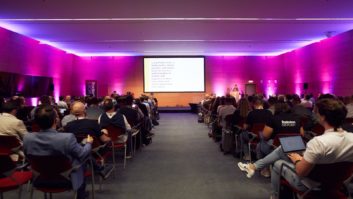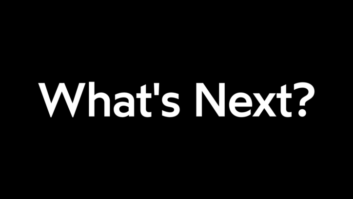Podcasting, distributing audio or video media files over the Internet using syndication feeds, aimed at playback on portable media devices or personal computers, may only seem a small blip on the total media radar.
But Podcasting has grown explosively since 2004, and has become a major or minor business model for a great many startups as well as established media companies.
This year NAB answers the need to quickly get media professionals up to speed by tripling the size of last year’s inaugural Podcasting Summit, with sessions on Friday, Saturday and Sunday at the front end of the 2007 NAB convention.
Friday features an intense Podcasting Boot Camp, with a three-hour session on “Audio Podcasting Essentials” followed by a three-hour “Video Podcasting Essentials” session.
“The boot camp is designed for those people who are newer to podcasting and don’t feel like they really understand the overview of the whole process from concept to delivery,” said Rich Harrington, conference program manager and owner of RHED Pixel, a video electronic design company. “So the boot camp is meant to be a comprehensive overview”
He said that the video and audio sessions are separated because of the considerable differences between those two types of podcasts.
Saturday and Sunday features a keynote address each day plus more than 20 individual sessions, encompassing not only technical subjects but podcast marketing, distribution, business tips and legal issues.
“The conference sessions take the big picture and go much deeper into individual areas, from legal issues to promotion to microphone selection and so forth,” said Harrington.
In reviewing last year’s Podcasting Summit in preparation for putting together this year’s version, Harrington said the program committee found that the 2006 summit sessions had two distinct audiences.
“You could clearly tell that the room was filled half with engineers, and the other half were marketing guys, business owners, major networks and small shops.”
This year the majority of the Saturday and Sunday sessions are divided into two tracks: one concentrating on more of the technical aspects, the other more on the business side.
Harrington will be presenting a pair of the sessions: Saturday evening’s “Field Production Strategies for Video Podcasting,” and Sunday afternoon’s “Creating a Graphical Identity for your Video Podcasts.”
While podcasting may seem a new and unproven territory for video production professionals making a living delivering videos to clients on tape or DVDs, one Podcasting Summit presenter encourages those professionals to look at delivering podcasting services as one more arrow in their quiver of services.
Philip Hodgetts, president of Intelligent Assistance, will make that case in his Sunday afternoon session “Offering Podcasting Production Services to Your Clients.”
“I think that the push technology will become another major delivery format for producers and content developers,” said Hodgett. “So it’s important for a content developer to understand the dynamics of what they need to do to prepare their material for this means of distribution.”
Hodgetts pointed out that video producers already have a firm grasp of the technology of shooting and editing, and often encoding the material for Web or DVD distribution. With a little training in podcasting, they can easily incorporate that service into their offerings.
Hodgetts will also present the Sunday afternoon session “Automating Podcast Workflows.”







